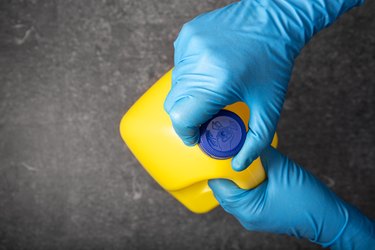
There's a specialized cleaning product for everything these days. This is mostly a positive (our great-great-grandmothers would have been amazed by Mr. Clean Magic Eraser!), but the variety of cleaners can also be confusing. While chlorine bleach and non-chlorine bleach sit side-by-side on the store shelves, they can't really be used interchangeably. Non-chlorine bleach, also called oxygen bleach or peroxide bleach, is great for erasing stains but not the most effective disinfectant.
Tip
Non-chlorine bleach is a less potent alternative to chlorine bleach, or common household bleach. Non-chlorine bleach generally uses hydrogen peroxide as an active ingredient, which kills germs and lifts stains but is much gentler than chlorine and safer to use on colored fabrics.
Video of the Day
What Is Chlorine Bleach?
What we generally think of as basic household bleach is also known as chlorine bleach. Soon after chlorine was discovered in the 1770s, it was found to be an effective whitening agent, and an early version of bleach was born. Today, a chlorine-based compound called sodium hypochlorite is the active ingredient in household bleach.
Video of the Day
How Is Chlorine Bleach Used?
Chlorine bleach has powerful whitening and disinfecting properties. When it makes contact with a stain molecule, a chemical reaction occurs that essentially strips the color out of the stain. That's what happens when chlorine bleach is used on white fabrics that have become yellow or dingy with age. The bleach strips the color out of those stain molecules to make whites look brighter.
The sodium hypochlorite in chlorine bleach is also strong enough to kill bacteria, viruses and fungi. When health authorities like the CDC advise disinfecting hard surfaces using a diluted bleach solution, they're talking about chlorine bleach. (The correct ratio for a disinfecting solution is 5 tablespoons bleach to every gallon of water, per the CDC.)
Of course, there's a flip side to chlorine bleach's potency. It can strip color out of non-white fabrics, create permanent stains and weaken fabrics. Bleach is corrosive and may damage certain materials, including metal and painted surfaces. Chlorine bleach and its fumes can also irritate skin and eyes and may be deadly if ingested in large doses. It should only be handled by an adult working in a ventilated room and wearing long gloves, and chlorine bleach should never be mixed with anything except water.
What Is Non-Chlorine Bleach?
Non-chlorine bleach generally uses hydrogen peroxide as the active ingredient. Hydrogen peroxide is made by adding an extra oxygen molecule to water. Instead of H20, its chemical composition is H202. (It's easy to see why "oxygen bleach" has become the common name for non-chlorine bleach.)
The extra oxygen creates an oxidizing reaction that can kill germs and strip color from porous surfaces, just like chlorine bleach. But hydrogen peroxide bleach is much less powerful than chlorine bleach.
How Is Non-Chlorine Bleach Used?
Non-chloride bleach is primarily used as a laundering agent, to lift stains and brighten dulled colors. Though generations of parents have used hydrogen peroxide to clean scraped knees and other wounds, it's not potent enough to thoroughly disinfect germy surfaces. (That said, some people still prefer using hydrogen peroxide to clean countertops, bathroom fixtures, toys and other non-porous surfaces because they don't like the strong smell of chlorine bleach.)
Non-chlorine bleach is safe to use on nearly all types and colors of fabrics. Generally, anything that's safe to wash with laundry detergent can be bleached with non-chlorine bleach. It can also be used as a stain remover for water-washable carpets and upholstered furniture. While non-chlorine bleach is safe to use on colorfast materials, it's always smart to test it on an inconspicuous spot on the fabric before using it to clean an entire garment or spot-treat a stained sofa.